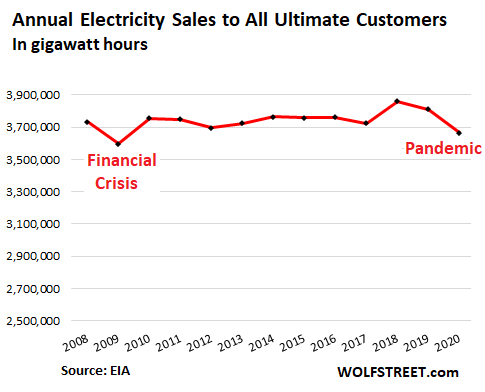Electricity Sales to End Users Dropped Below 2008 Level: What it Says about the Pandemic Economy, Households, Commercial & Industrial Activity, and Public Transportation
In 2020, by source, coal collapsed to record low, natural gas dominated, wind and solar surged, while hydro and nuclear remained roughly flat.
Electricity sales to all end users in the US – households, office buildings, industrial buildings, and the like – have been on a dreary trajectory since 2008 for electric utilities overall in the US, despite economic and population growth, as these customers have invested in more efficient electrical equipment such as LED light bulbs and new air conditioners, and better thermal insulation, while at the same time, more manufacturing has been offshored.
And then came the Pandemic. By customer type, electricity sales show the shifts in the economy as millions of jobs evaporated, and as other jobs were switched from desk farms in office towers to working from home, while many retailers and restaurants closed, industrial plants reduced activity, and usage of commuter rail collapsed.
In 2020, total electricity sales to ultimate customers dropped by 3.9% to 3.66 million gigawatt hours, after having already dropped 1.2% in 2019, according to new data by the Energy Department’s EIA. These two drops brought electricity sales below the 2008 level:

Electricity sales to residential customers ticked up 1.5% from 2019 to 1.46 million gigawatt hours, though they remained a tad below the record sales of 2018. Households who switched to work-from-home and learning-from-home saw the rising number of kilowatt hours they were paying for as they ran their air conditioners, heaters, computer equipment, lights, and other stuff all day long.
And heat played a role, with a number of states reporting a record hot July, followed by the third hottest August on record in the US overall…
…click on the above link to read the rest of the article…